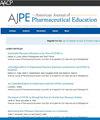药师学生职业认同形成及影响因素评估
IF 3.8
4区 教育学
Q1 EDUCATION, SCIENTIFIC DISCIPLINES
引用次数: 0
摘要
目的:评估美国一所药学院学生药师的职业认同(PI),并确定PI的预测因素。方法:本初步研究于2024年1月对休斯顿大学药学院的所有学生进行了横断面调查。调查工具包括旨在衡量参与者人口统计、药房工作经验、组织参与、领导、指导和研究参与的项目。采用麦克劳德·克拉克职业认同量表(MCPIS-9)测量PI。MCPIS-9使用5分李克特量表,潜在得分范围从9到45。由于MCPIS-9的得分偏左,因此被调查者被划分为五位数。Kruskal-Wallis检验评估了MCPIS-9评分与PI相关的关系,而逐步选择的有序逻辑回归评估了参与者特征与MCPIS-9排名之间的调整相关性。结果:器械应答率为55.1%(244/443)。一到四年级学生的MCPIS-9中位数分别为37、36、36和38,反映了学生药剂师的PI水平一直很高。有序逻辑回归显示,白人学生、参加过药学会议的学生或有预科药学工作经验的学生有更高的PI。结论:药师学生PI水平总体较高。白人种族、药学会议经验和预科药学工作经验是PI的显著预测因子。促进和创造平等的专业会议和就业机会,可能会加强学生药师的PI。在评估PI时,考虑具有边缘化身份的个体的PI可能有何不同也很重要。本文章由计算机程序翻译,如有差异,请以英文原文为准。
Assessment of Professional Identity Formation and Influencing Factors in Student Pharmacists
Objective
To assess professional identity (PI) in student pharmacists at a single pharmacy college in the United States and identify predictors of PI.
Methods
This pilot study administered a cross-sectional survey to all University of Houston College of Pharmacy students in January 2024. The survey instrument included items intended to measure participant demographics, pharmacy work experience, organizational involvement, leadership, mentorship, and research involvement. The nine-item Macleod Clark Professional Identity Scale (MCPIS-9) was used to measure PI. The MCPIS-9 uses a 5-point Likert scale, with potential scores ranging from 9 to 45. Given that MCPIS-9 scores were left-skewed, respondents were ranked into tertiles. The Kruskal-Wallis test assessed the association between MCPIS-9 scores and PI correlates, while ordinal logistic regression with stepwise selection estimated adjusted associations between participant characteristics and MCPIS-9 ranking.
Results
The instrument response rate was 55.1% (244/443). The median MCPIS-9 scores for first- through fourth-year students were 37, 36, 36, and 38, respectively, reflecting consistently high levels of PI among student pharmacists. Ordinal logistic regression demonstrated that students who were White, had attended a pharmacy conference, or had prematriculation pharmacy work experience had higher PI.
Conclusion
The overall level of PI among student pharmacists was high. White race, pharmacy conference experience, and prematriculation pharmacy work experience were significant predictors of PI. Promoting and creating equal accessibility for professional conferences and employment is likely to strengthen PI in student pharmacists. It is also important to consider how PI may differ for individuals with marginalized identities when evaluating PI.
求助全文
通过发布文献求助,成功后即可免费获取论文全文。
去求助
来源期刊
CiteScore
4.30
自引率
15.20%
发文量
114
期刊介绍:
The Journal accepts unsolicited manuscripts that have not been published and are not under consideration for publication elsewhere. The Journal only considers material related to pharmaceutical education for publication. Authors must prepare manuscripts to conform to the Journal style (Author Instructions). All manuscripts are subject to peer review and approval by the editor prior to acceptance for publication. Reviewers are assigned by the editor with the advice of the editorial board as needed. Manuscripts are submitted and processed online (Submit a Manuscript) using Editorial Manager, an online manuscript tracking system that facilitates communication between the editorial office, editor, associate editors, reviewers, and authors.
After a manuscript is accepted, it is scheduled for publication in an upcoming issue of the Journal. All manuscripts are formatted and copyedited, and returned to the author for review and approval of the changes. Approximately 2 weeks prior to publication, the author receives an electronic proof of the article for final review and approval. Authors are not assessed page charges for publication.

 求助内容:
求助内容: 应助结果提醒方式:
应助结果提醒方式:


